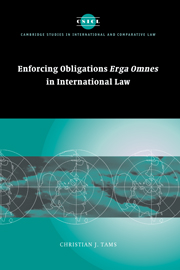Book contents
Part II - Legal issues raised by the erga omnes concept
Published online by Cambridge University Press: 24 July 2009
Summary
It is against the background set out in the preceding chapters that the concept of obligations erga omnes has to be seen. It emerged in a legal environment torn between traditional, restrictive concepts of individual injury on the one hand, and expansive approaches to standing on the other. As has already been stated in the Introduction, the instance of its emergence – two obscure, though soon-to-be-famous, paragraphs of a judgment otherwise concerned with the diplomatic protection of corporations – was a most unlikely one. The Barcelona Traction dictum however has been followed up by further references to the erga omnes concept, which to date has been mentioned in no less than eight other proceedings, namely in the orders or judgments in the Namibia, Nuclear Tests, Nicaragua, East Timor, Genocide, Gabčíkovo, Armed Activities (Congo-Rwanda), and Israeli Wall cases. To these, a considerable number of separate and dissenting opinions has to be added. Despite the frequent judicial endorsement, the ‘masterpiece’ has escaped an easy classification. Three questions in particular – foreshadowed already in the Barcelona Traction dictum – have remained controversial.
The most fundamental of these is whether the erga omnes concept affects the rules of standing. In the Barcelona Traction dictum, the Court seemed to address this question when observing that obligations erga omnes are the ‘concern of all States’ and ‘owed towards the international community as a whole’; that ‘all States … have a legal interest in their protection’, and that they enjoy ‘corresponding rights of protection’.
- Type
- Chapter
- Information
- Enforcing Obligations Erga Omnes in International Law , pp. 97 - 98Publisher: Cambridge University PressPrint publication year: 2005

